North America is home to a diverse array of wren species, with a total of 11 varieties identified. Among these, Michigan has the privilege of hosting 7 different species. Out of the 7, 5 are considered regular visitors, while the remaining 2 are considered accidental guests. This guide aims to assist you in recognizing these wrens by both their appearance and their melodic voices.
Michigan’s year-round wren resident is the Carolina Wren, adding a touch of charm to the state’s landscapes. During the summer months, House Wrens, Winter Wrens, Marsh Wrens, and Sedge Wrens can be observed in Michigan. Additionally, keep an eye out for Rock Wrens and Bewick’s Wrens as they grace the state with their presence.
These wrens may seem unremarkable at first glance, but they possess fascinating personalities. Sporting a modest brown plumage, they are relatively small and pleasantly plump birds. Their distinctively upright tails and powerful voices set them apart.
It’s important to note that wrens are categorized as New World birds, found in the Americas, excluding the Eurasian Wren which resides in Europe and Africa. Belonging to the Troglodyidae family, these charismatic creatures have adapted to thrive in a variety of environments, including arid and rocky areas with sparse vegetation. This adaptability is partly due to their diet, which consists primarily of insects and spiders.
Previously, it was believed that the Winter Wren, Pacific Wren, and Eurasian Wren were one and the same. However, they have since been recognized as three distinct species. Wrens have also accumulated rich folklore and symbolism throughout history. In Europe, for example, it was once believed that harming a wren would result in bad luck.
To aid in the identification of wren species in Michigan, this guide follows avibase’s recommendations. The list is arranged based on the frequency of sightings, as reported by avid birdwatchers and their checklists submitted to ebird.
For a helpful resource in identifying various bird species that visit your backyard, consider printing a free bird identification photo guide tailored specifically for Michigan.
Here is a list of the 7 wren species found in Michigan:
1. House Wren
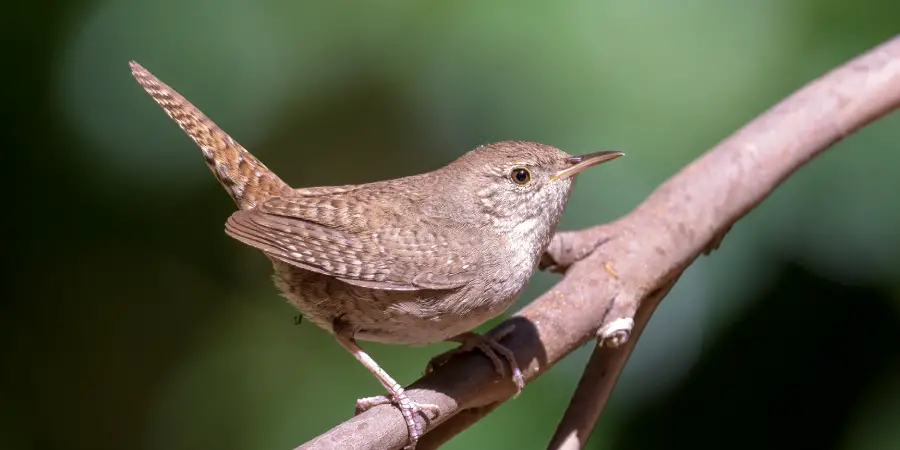
During the summer months, House Wrens are the most commonly spotted wrens in Michigan, appearing in approximately 21% of checklists submitted by birdwatchers. Their presence can be observed from March through November.
House Wrens are small, unassuming birds with rounded bodies. Their wings and tails display darker barred patterns, while their throats appear lighter. Males and females share a similar appearance.
Key features: Their eyestripe is less pronounced compared to other wren species.
Scientific name: Troglodytes aedon
Length: 4.3-5.1 inches (11-13 cm)
Weight: 0.3-0.4 ounces (10-12 g)
Wingspan: 5.9 inches (15 cm)
House Wrens breed in the United States and southern Canada during the summer, migrating to the southern regions and Mexico for the winter. You can often find them energetically hopping through vegetation, singing their cheerful melodies while foraging for insects and spiders. Their diet also includes snail shells, providing them with a calcium source.
When it comes to their songs, House Wrens may lack a melodic tune, but they make up for it with a series of jumbled notes that vary in pitch and speed.
These wrens construct their nests in old woodpecker holes, nest boxes, or small crevices. They have a preference for lightly wooded areas and build their nests using twigs, often lining them with softer materials. House Wrens typically lay 3
to 10 eggs, with an incubation period of approximately two weeks. The chicks require an additional two weeks to fledge.
To attract House Wrens to your backyard, consider leaving brush piles or installing nest boxes.
Fun fact: Despite their small size, House Wrens are known for their fierce nature. They often harass larger birds to secure the best nest sites, occasionally even removing eggs or nestlings from existing nests.
2. Carolina Wren
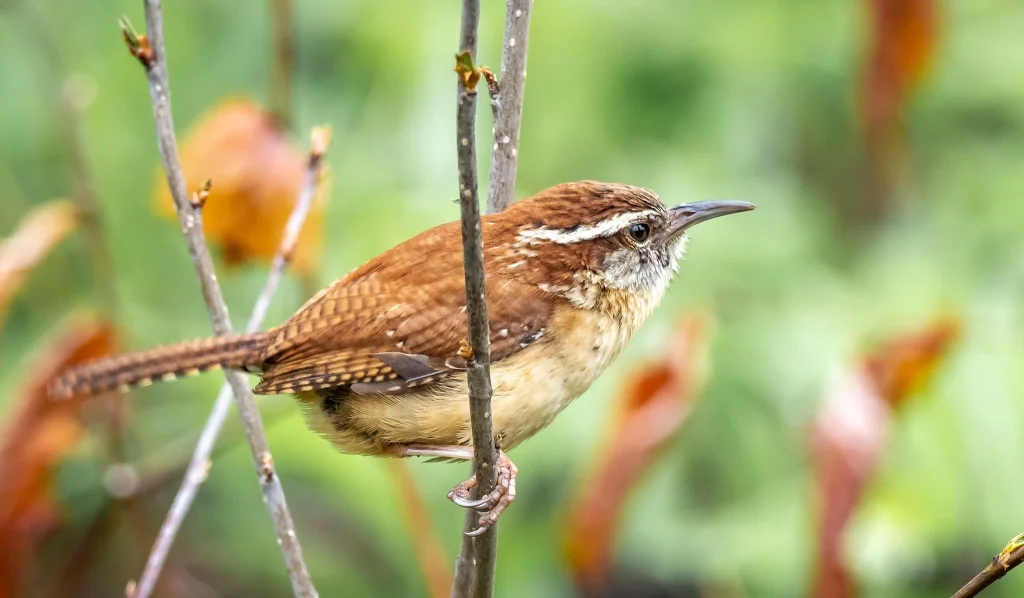
Carolina Wrens can be found in Michigan throughout the entire year. Approximately 3% of summer checklists and 5% of winter checklists submitted by birdwatchers note their presence.
These shy birds feature dark brown plumage on their upper bodies and lighter shades of brown on their undersides. They possess a distinct white eyebrow stripe and an upright tail.
Scientific name: Thryothorus ludovicianus
Length: 4.7-5.5 inches (12-14 cm)
Weight: 0.6-0.8 ounces (18-22 g)
Wingspan: 11.4 inches (29 cm)
Carolina Wrens are year-round residents throughout the Eastern and Southeastern United States. You can spot them in wooded areas, thick vegetation, and even at backyard feeders. Their diet primarily consists of insects and spiders, but they may occasionally consume lizards, frogs, and snakes.
When it comes to their songs, Carolina Wrens emit short, quick whistles.
Carolina Wren nests are typically located in trees, although they are adaptable and can build nests in various natural or artificial locations. Their nests often have a nearly circular shape with a small opening on the side. These wrens lay 3 to 7 eggs, and the incubation period lasts around two weeks. The chicks require an additional two weeks to fledge.
To attract Carolina Wrens to your backyard feeders, consider offering suet feeders, hulled sunflower seeds, or peanut hearts in large tube or platform feeders.
Fun fact: Carolina Wrens are known for forming lifelong pairs.
3. Winter Wren
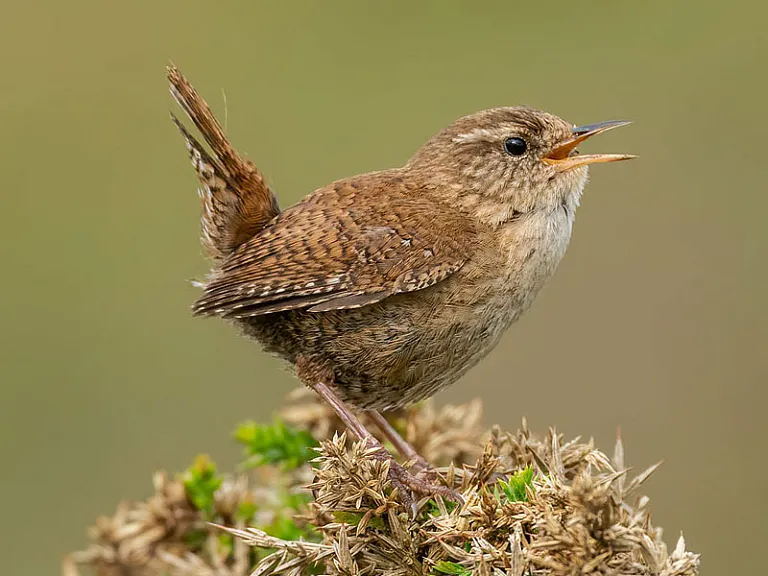
While some Winter Wrens can be observed in Michigan throughout the year, they are more commonly seen during the breeding season, appearing in approximately 2% of summer checklists.
Winter Wrens are small, plump birds with brown plumage. They exhibit darker barring on their wings, tail, and belly. A paler eyebrow stripe and short, upright tails further distinguish them. Male and female Winter Wrens have similar appearances.
It is worth noting that Winter Wrens closely resemble Pacific Wrens and were initially considered the same species. However, they have since been recognized as separate species due to distinct vocalizations.
Scientific name: Troglodytes hiemalis
Length: 3.1-4.7 inches (8-12 cm)
Weight: 0.3-0.4 ounces (8-12 g)
Wingspan: 4.7-6.3 inches (12-16 cm)
Winter Wrens can be found in the eastern United States during winter, while they migrate to northeastern states and Canada during the summer.
To spot Winter Wrens, pay attention to their hiding places within tangled undergrowth in forests and backyards. They feed on insects and spiders by rummaging through fallen leaves and decaying bark.
Winter Wrens emit a long, bubbly, sweet song that lasts up to 10 seconds. Their songs differ from those of Pacific Wrens.
When building nests, Winter Wrens weave twigs, moss, and grass together into a round shape with a small opening. They lay 1 to 9 eggs, with an incubation period of approximately two to two and a half weeks. Fledging occurs within the same timeframe.
To attract Winter Wrens to your backyard, incorporate native plants and dense vegetation.
Fun fact: Winter Wrens construct round nests with small openings, sometimes even suspending them from trees.
4. Marsh Wren
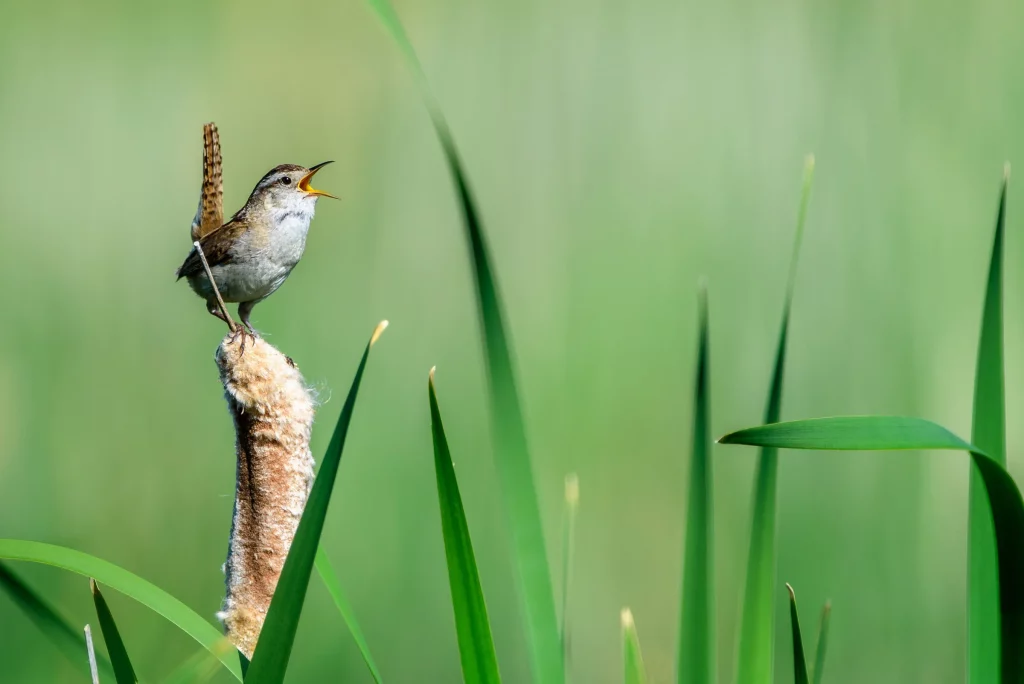
During the breeding season, Marsh Wrens can be observed in Michigan, accounting for approximately 3% of summer checklists. They are most commonly seen from May to October, but a few individuals may remain in the state throughout the year.
Marsh Wrens have brown plumage with black and white streaks on their backs. Their undersides display a grayish-brown hue, and they possess the characteristic upright tail found in wrens. Notably, Marsh Wrens lack striped shoulders and have longer bills compared to Sedge Wrens. Males and females share a similar appearance.
Scientific name: Cistothorus palustris
Length: 3.9-5.5 inches (10-14 cm)
Weight: 0.3-0.5 ounces (9-14 g)
Wingspan: 5.9 inches (15 cm)
Marsh Wrens breed in northern US states and central Canada before migrating to southern states and Mexico. Some individuals in the western regions and along the Atlantic Coast may remain year-round. During migration, they can be spotted in the eastern United States.
To locate Marsh Wrens, explore wetland areas where they cling to reeds, utilizing their feet to grip different stalks. While they may be challenging to spot, their distinctive buzzy songs, particularly at dawn and dusk, can provide hints to their presence.
Their diet primarily consists of insects and spiders, which they pick off leaves close to the water.
Marsh Wrens construct fully enclosed nests, leaving only a small opening at the top. They build their nests using reeds and grasses woven together. These wrens lay 3 to 10 eggs, with an incubation period of around two weeks. Fledging occurs within two weeks.
Fun fact: Marsh Wrens may build multiple dummy nests attached to cattails, but they typically use only one nest, destroying the eggs and nestlings of rival birds.
5. Sedge Wren
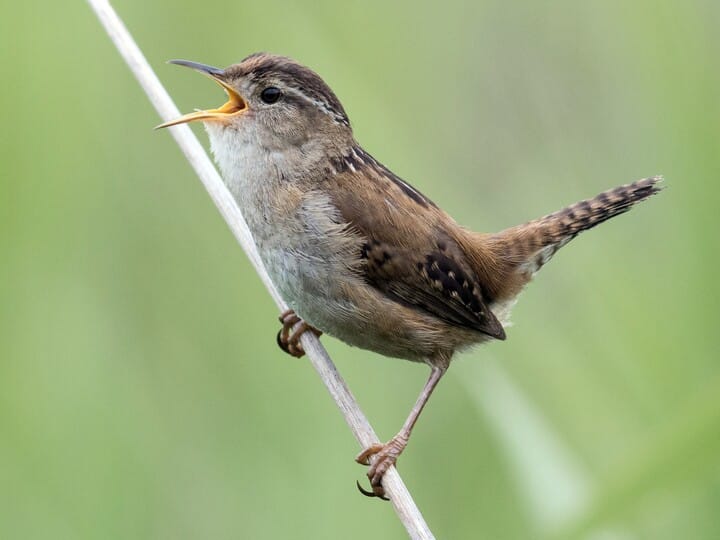
Sedge Wrens spend their breeding season in Michigan, appearing in approximately 1% of summer checklists. They begin arriving as early as April and may stay until October, with the best months for spotting them being May through September.
Sedge Wrens are small brown wrens with darker streaks and barring on their backs and paler undersides. They feature a light eyebrow stripe. Males and females share similar coloring.
It’s worth noting that Sedge Wrens resemble Marsh Wrens and can be found in similar wet habitats. However, Marsh Wrens lack striped shoulders and possess lighter bellies.
Scientific name: Cistothorus stellaris
Length: 3.9-4.7 inches (10-12 cm)
Weight: 0.3-0.3 ounces (7-10 g)
Wingspan: 4.7-5.5 inches (12-14 cm)
Sedge Wrens breed in southern Canada, the Midwest, and occasionally extend further east in the United States. They migrate to spend their winters in southeastern states and northern Mexico, particularly near the Gulf and Atlantic coasts.
To spot Sedge Wrens, search for them amidst wet grasslands, marshy areas, and meadows with abundant vegetation. They typically prefer shallower areas compared to Marsh Wrens and actively hunt for insects and spiders.
Sedge Wrens emit a simple song consisting of a few short notes followed by a series of more rapid notes at a similar pitch.
When it comes to nesting, Sedge Wrens select hidden spots in wet grasslands, marshy areas, and meadows.
They build cup-shaped nests using sticks and grasses, lining them with softer materials. These wrens lay 3 to 8 eggs and have an incubation period of approximately two weeks. Fledging occurs within the same timeframe.
Fun fact: Sedge Wrens are known to pierce the eggs of neighboring Sedge Wrens that nest too close, effectively destroying them.
6. Rock Wren

Rock Wrens are considered accidental visitors to Michigan, and according to records, they were last spotted in the state back in 2018.
Rock Wrens have pale brown backs with darker flecks. Their wings and tails display barring, while their undersides appear pale, often featuring buff coloring on the lower flanks and belly. Notable features include a pale eyebrow stripe, a long slightly curved bill, and dark legs. Males and females share the same coloring. Rock Wrens exhibit a distinctive bobbing motion, particularly when agitated, aiding in their identification.
Scientific name: Salpinctes obsoletus
Length: 4.9-5.9 inches (12.5-15 cm)
Weight: 0.5-0.6 ounces (15-18 g)
Wingspan: 8.7-9.4 inches (22-24 cm)
Rock Wrens are primarily found in dry and rocky areas in western US states and southwest Canada. While individuals in the southern and western regions remain year-round, those in central US states migrate south for the winter.
To locate Rock Wrens, explore dry and rocky areas with minimal vegetation. They feed on insects found within crevices in rocks.
Rock Wrens are known for their diverse repertoire of songs, often repeating a particular sound several times before transitioning to a different sound. Each rendition showcases a different pitch.
When building nests, Rock Wrens typically select cavities or depressions in rocky areas. They add a layer of small stones followed by softer materials like wool and moss. These wrens may lay up to 8 eggs and produce up to 3 broods per year.
Fun fact: Rock Wrens construct stone walkways leading to their nests, although the purpose behind this behavior remains unknown. Additionally, they acquire all the necessary moisture from their diet of insects and do not drink water.
7. Bewick’s Wren
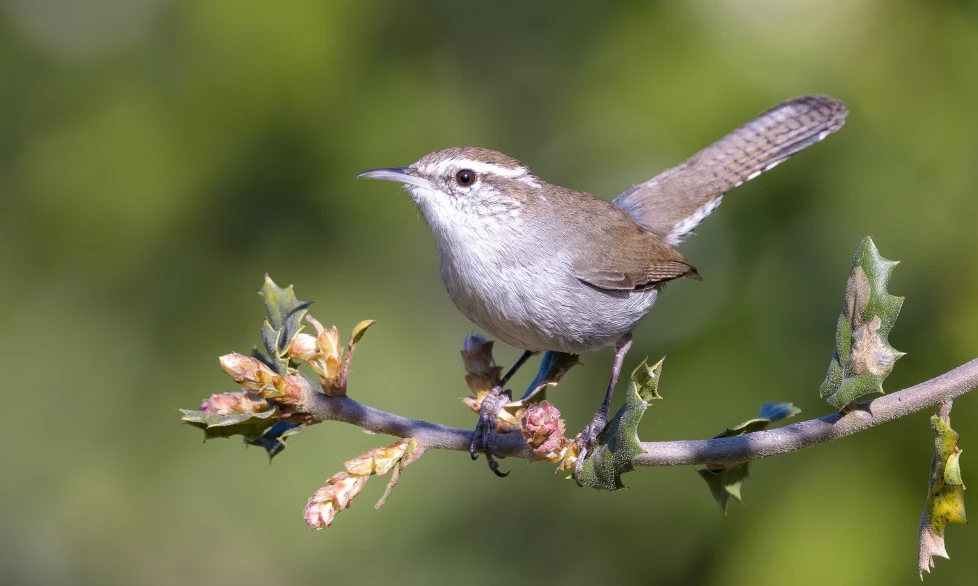
Bewick’s Wrens are considered extremely rare and accidental visitors to Michigan, rarely observed within the state.
Bewick’s Wrens feature brown backs, long gray upright tails with dark barring, gray bellies, and a white stripe over the eye.
Scientific name: Thryomanes bewickii
Length: 5.1 inches (13 cm)
Weight: 0.3-0.4 ounces (8-12 g)
Bewick’s Wrens reside in southern and western states year-round, with minimal winter movements.
You can find Bewick’s Wrens in scrub, thickets, and open woodlands. They move from branch to branch, flicking their long tails. In terms of diet, they primarily feed on insects and larvae, including bees, bugs, caterpillars, and beetles.
Bewick’s Wrens emit a song consisting of a couple of short higher notes followed by lower-pitched buzzy notes.
Nests of Bewick’s Wrens are typically found on rock ledges, old woodpecker nests, nest boxes, or crevices in buildings. They construct cup-shaped nests using sticks and grasses, lining them with softer materials. These wrens lay 3 to 8 eggs, with an incubation period of approximately two weeks. Fledging occurs within the same timeframe.
To attract Bewick’s Wrens to your backyard, consider offering suet, mealworms, and hulled sunflower seeds.
Fun fact: Bewick’s Wrens have experienced population declines in the eastern United States, possibly due to the presence of House Wrens, which may destroy their eggs.
How to Attract Wrens to Your Backyard
Welcoming wrens to your backyard provides an opportunity to enjoy their melodious songs and observe their energetic behavior up close. While only a few species of wrens regularly visit backyards, such as House Wrens, Carolina Wrens, and Bewick’s Wrens, you can take steps to attract them:
1. Embrace a slightly untidy environment: Provide habitats for insects and spiders, which form the wrens’ favorite food. Leave fallen leaves, brush piles, and allow spider webs to remain undisturbed.
2. Provide clean water sources: Consider incorporating running water features in multiple locations within your backyard.
3. Offer nesting sites: Wrens readily utilize nest boxes or even unconventional options like old boots left outdoors.
4. Provide suitable food: Wrens enjoy mealworms, crickets, peanuts, and suet. Consider placing feeders with these food sources.
Frequency of Wren Sightings in Michigan during Summer and Winter
Checklists serve as valuable resources for identifying commonly spotted bird species. The following lists outline the frequency of wren sightings based on birdwatchers’ checklists submitted to ebird during summer and winter in Michigan:
Wrens in Michigan in Summer:
– House Wren: 21.8%
– Marsh Wren: 3.8%
– Carolina Wren: 3.7%
– Winter Wren: 2.1%
– Sedge Wren: 1.7%
– Rock Wren: <0.1%
– Bewick’s Wren: <0.1%
Wrens in Michigan in Winter:
– Carolina Wren: 5.0%
– Winter Wren: 0.6%
– Marsh Wren: <0.1%
– Rock Wren: <0.1%